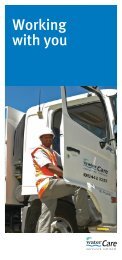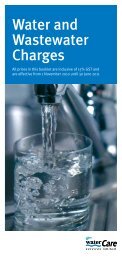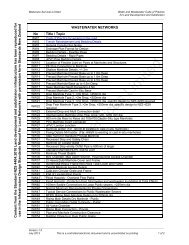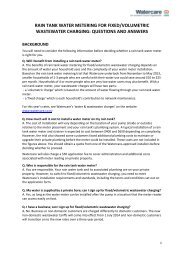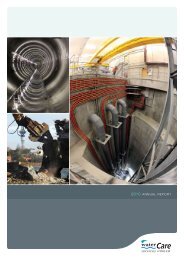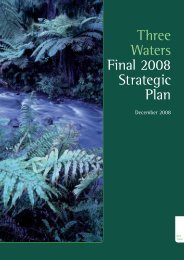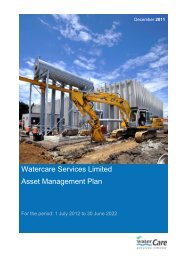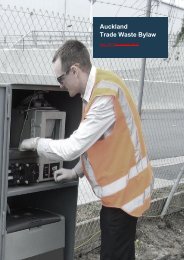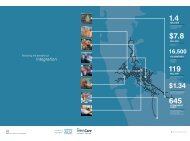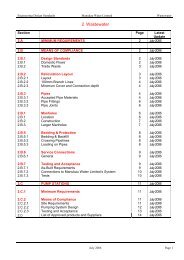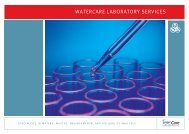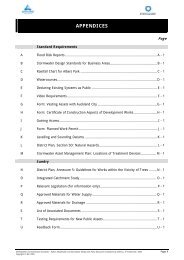Annual Report 2011 - Watercare
Annual Report 2011 - Watercare
Annual Report 2011 - Watercare
You also want an ePaper? Increase the reach of your titles
YUMPU automatically turns print PDFs into web optimized ePapers that Google loves.
<strong>Watercare</strong> Services Limited<br />
<strong>2011</strong> ANNUAL REPORT<br />
<strong>2011</strong> STATEMENT OF SERVICE PERFORMANCE<br />
Environmental care<br />
(a) To promote conservation of the region’s water resources.<br />
(i) To develop and initiate the implementation of a regional water efficiency and conservation plan for the integrated company by 30 June <strong>2011</strong>.<br />
The Auckland Regional Water Demand Management Plan, which includes initiatives and actions to help reduce water demand, was completed<br />
and sent to the Auckland Council on 30 June <strong>2011</strong>. The plan was developed in consultation with a range of stakeholders including the<br />
Auckland Council and the Environmental Advisory Group and is aimed at reducing or delaying the need to access new water sources and<br />
future capital expenditure. <strong>Watercare</strong> has adopted the Three Waters strategic demand target of achieving a 15% reduction on the 2004 level<br />
of water demand by 2025. Implementation of the plan involves working closely with a range of stakeholders.<br />
(ii) To maintain regional unaccounted for water losses at less than 17.7 billion litres. (Applicable from 1 November 2010)<br />
A proportion of the water supplied by <strong>Watercare</strong> is not invoiced (non-revenue water) because it is used as part of the production process<br />
(such as flushing), for fire fighting, meter inaccuracy and unauthorised usage. Some of these volumes are calculated based on the best<br />
information available and other industry-accepted parameters. The balance of non-revenue water is unaccounted for water losses and was<br />
estimated at 11.4 billion litres against a seasonally-adjusted eight-month target of 12.1 billion litres for the post-integration period. Part of<br />
the forward programme is to improve the accuracy of the measurement of non-revenue water volumes.<br />
(b) To promote to industry cleaner discharges.<br />
(i) To achieve a ‘Bb’ grade as set out in the 2003 NZWWA guidelines for the safe application of biosolids to land.<br />
Biosolids metals testing for the 2010/11 year showed that 97% of tests confirmed the Bb grade or better for biosolids. During the year<br />
there was a spike in zinc levels at the Mangere wastewater treatment plant. As biosolids are blended as part of the disposal process, overall<br />
biosolids for the year were Bb grade. In general the predominant source of zinc to the wastewater system is stormwater, which contains<br />
galvanised roofing and road (wear on tyres and brakes) runoff and enters via the combined sewer/stormwater system that exists in parts<br />
of Auckland. The period of recorded elevated zinc levels may be the result of the cleaning of the stormwater system or the result of illegal<br />
dumping from industrial sites. Inquiries were ongoing to identify the cause.<br />
(c) To minimise the impact of carbon on the environment.<br />
(i) To achieve a 75% CO 2<br />
equivalent reduction from 1990 levels over the next three years.<br />
The estimated levels of greenhouse gas emissions have been reduced dramatically since 1990. This has been achieved by the removal of<br />
oxidation ponds at Mangere and their reduced usage at Rosedale, the removal of sludge lagoons and the collection of methane for electricity<br />
generation at both these wastewater treatment plants. For Mangere alone, the reduction has been 86%. By comparison with the levels at<br />
these two largest plants, emission levels elsewhere in the company are minor, but the company continues to implement policies to reduce<br />
these levels. Based on accepted IPCC extrapolation factors, estimates for significant 1990 emissions across the integrated company indicate<br />
that the 75% target was achieved for 2010/11.<br />
(d) To use energy efficiently and where appropriate recover energy from operational activities.<br />
(i) To target 35% of energy needs sourced internally for each of the next three years.<br />
This year, <strong>Watercare</strong> sourced 32% of its energy internally, principally from biogas reuse at its two largest wastewater plants, Mangere and<br />
Rosedale, and from five hydro-electric generators within the water supply system.<br />
Health, safety and well-being<br />
(a) To promote staff productivity and wellbeing.<br />
(i) To attain a lost-time injury frequency rate (LTIFR) of less than or equal to 5.<br />
<strong>Watercare</strong> staff achieved a LTIFR rate of 3.22, which was well within the target range. Prior to a serious incident at Onehunga, Auckland,<br />
on 4 June <strong>2011</strong> <strong>Watercare</strong> had operated for 18 months without a lost-time injury.<br />
(ii) To target an unplanned absenteeism rate of less than 2.5%.<br />
<strong>Watercare</strong> achieved an unplanned absenteeism rate, including sick leave, of 2% (equivalent to 4.5 days per employee), which was within<br />
the target range.<br />
(b) To provide comprehensive training and development programmes.<br />
(i) To target over 20 training hours per employee.<br />
Employees received 20.7 hours of training each on average. This result was slightly higher than the performance target and reflects the<br />
company-wide focus on integration.<br />
(ii) To target a ratio of less than 2.25:1 of external to internal appointments.<br />
The ratio of external to internal appointments was 1.2:1, being 12 external appointments for every 10 internal appointments. This ratio<br />
was influenced by the integration of the company under Part 2 of the Local Government (Auckland Transitional Provisions) Act 2010.<br />
Staff transferred from the local network operators (LNOs) were considered internal appointments.<br />
(c) To provide employees with safe working conditions.<br />
(i) To maintain the tertiary-level ACC workplace management practices accreditation.<br />
ACC tertiary-level accreditation was maintained following an audit in December 2010.<br />
<strong>2011</strong> Financial <strong>Report</strong><br />
PAGE 107<br />
Return to Contents page



